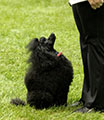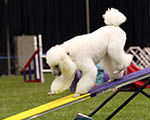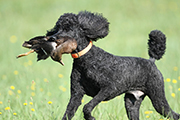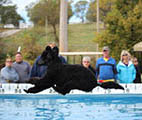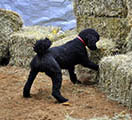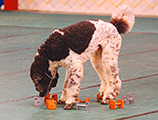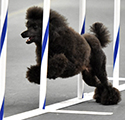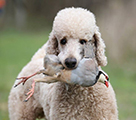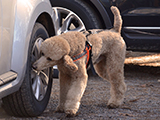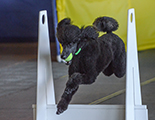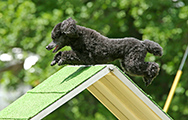The Temperament Test
What: A temperament test is a set of evaluations/tests that is designed to help evaluate the interest, aptitude, learning ability, and personality of a dog to better match the dog with an owner who is looking for a dog with a particular potential.
Who: All breeders and all buyers should have access to the data necessary to help better improve the match or “fit” between a dog and its new owner. An educated and more scientific method of matching dog and buyer will help to insure a long and happy association for everyone involved. In the process of making these evaluations all parties should better assess their goals and aspirations and what they do and don’t want in this new relationship. A knowledgeable and interested breeder can be a great help in temperament evaluation of a litter as the breeder has been observing each puppy as it interacts with its littermates and its mother and other people since birth.
When: The breeder should first begin evaluating the puppies in a litter when they are 3 days of age. Elaborate notes should be kept on these observations. Each puppy should be identified *from birth so that changes and differences between puppies can be noted. (See Infant Puppy Education) Ideally, a litter of puppies will be tested by a stranger between 7 and 8 weeks of age. Tests can be designed for the older dog and many rescue organizations have a well-developed testing program for rescue dogs in order to facilitate a good match to a new home.
Where: The test should be done in an area unfamiliar to the dog. In order to make comparisons between puppies the environment should be similar for each puppy. In other words, similar time of day, level of sleepiness, and environmental temperature. An excellent site would be a large garage with a clean floor and good light with closed doors or an unfamiliar enclosed small yard. Puppies who have recently eaten may be too sleepy to adequately test and others who have been playing hard may be too tired to adequately test. This means that you may have to take all day or even do the testing on 2 different days.
Props: The tester and breeder should have on hand all the equipment needed for the testing. The tester should be a stranger to the puppies and someone who is experienced in a wide range of dog work. Some of the items needed will be a piece of cardboard about 2 feet by 6 feet, a piece of chicken wire about 2 feet by 6 feet, balls, socks, exercise pen, broom handle with a 6 foot cord on the end and a tie for attaching a toy or bird wing, a noisy toy, a whistle, a pull-toy, a bumper, a pill bottle half full of lead or steal pellets, 2 or 3 live pigeons** (depending on number of dogs to be tested), dumbbell and any other items you have considered to help evaluate the puppies for your particular interest. Be sure that you have a large notebook for record keeping.
General comments: These tests are only examples. You should decide the purpose for which you want to evaluate the litter and design your tests to evaluate the task aptitude that you want the dogs to perform as adults. If you are only interested in conformation you will want to evaluate structure, noise sensitivity and sociability. If you are looking for an obedience prospect you will want a dog who does natural eye contact, has a good square sit, good structure, especially a correct front, sociability, low noise sensitivity, natural retrieve instinct and a desire to please. For tracking you want a dog that demonstrates a desire to use his nose, although all dogs use their noses very well, plus the obedience requirements. For field work (hunting) you want all of the above plus a dog that has great terrain courage and love of (or at least not fear of) water and perseverance. Most of these aptitudes and interests are very hereditary, so also evaluate the parents of your prospective puppy. For example, at 8 weeks it is more important to know if both parents love water than if the puppy is playing in water, as this often develops later. A very noise sensitive parent tends to have noise sensitive offspring. Dogs not interested in
retrieving tend to have similar offspring.
Tester: Plan the sequence of tests and prepare your note taking so that you can save time by entering check marks. You may want to have a “scribe” hidden away who can take notes for you as you do the testing. Decide how you will evaluate each item and try to be consistent in the order of testing and the test set up for each puppy. Sociability should be tested first, as after other tests are done, the tester is no longer a stranger to the puppy.
Breeder: The breeder should have been preparing the puppies for their testing by regular grooming, playing with the puppies, nail trimming weekly since birth, and close observations of their social ranking in the litter and interactions with littermates and mother. On the day of the test the puppies should be fed about 2 hours before start of testing and then allowed to sleep until the tester arrives. If it is a large litter you may want to divide in half and feed the second half when the tester arrives, as it can take about 15 to 30 minutes to test each puppy. After a couple hours of testing the untested puppies are tired out too if they have been awake and playing during the entire time.
——————————
*There are many methods of puppy identification. The author uses colored craft ric-rac as a collar for each puppy. Each puppy has it’s own color code. The collar is changed every 2 or 3 days as the puppies grow. The mothers seem not to mind this little collar on each puppy.
**Call your local Retriever Club to find out where they get their pigeons for field tests, look in the yellow pages for game birds, or find a local retriever trainer who can loan you 2 or 3 pigeons. You can transport the birds in a small dog crate or cat crate.
Doing the Test
| TEST | SCORE | COMMENTS |
| SOCIABILITY | ||
| follow | ||
| whistle | ||
| eye contact | ||
| tester squat | ||
| floor play | ||
| PREY DRIVE | ||
| bird wing pull | ||
| bumper roll | ||
| toy toss | ||
| pulled noisy toy | ||
| NOISE SENSITIVITY | ||
| pill bottle roll | ||
| loud toy | ||
| clap hands | ||
| pop gun | ||
| TERRAIN COURAGE | ||
| retrieve X obstacle | ||
| follow X obstacle | ||
| retrieve X 2nd obstacle | ||
| enter water | ||
| traverse bank or brush | ||
| BIRDINESS | ||
| attraction | ||
| persistence | ||
| aggression | ||
| retrieve | ||
| STRUCTURE | ||
| front | ||
| head and mouth | ||
| topline | ||
| forechest | ||
| rear | ||
| tail set | ||
| movement | ||
| sit | ||
| GENERAL | ||
| dog interactions | ||
| forwardness | ||
| food interest | ||
| independence | ||
| courage |
Interpretation of Test
Prior to testing a litter you should decide upon a scoring system. I use a 1 to 5 score with 5 being the best I have ever observed on the item and 1 being a dog which demonstrates total lack of interest or fear. i.e a dog with NO potential as a working dog demonstrated on this item of the test.
In the Sociability tests you should look for a puppy which readily follows you with tail up and a prance, great eye contact with you from the moment of placing puppy on floor, comes when you gently blow a whistle and runs to you enthusiastically when you squat on the floor.
In the Prey Drive tests you hope to find a puppy which enthusiastically chases a bird wing which you pull along the floor, chases the bumper rolled across the testing area, runs after each toy which is tossed, picks it up and runs back to you with it or at least picks it up and plays. He should investigate the noisy pulled toy, have tail up most of the time while investigating the toy and then joyfully follow the toy as you push or pull it about the testing area.
In the Noise Sensitivity area the puppy should investigate a noisy and erratically moving rolled pill bottle then not be bothered by it. A rare puppy will even retrieve this object. They should investigate a noisy toy and be interested in retrieving it. Clapped hands should elicit interest with tail up and then approach to you. The pop gun should startle and then interest the pup. If it freezes or runs away with tail down this is a potentially seriously noise sensitive dog.
In the Terrain Courage tests the puppy should pay little or no attention to crossing a large piece of cardboard or chicken wire to get to his retrieve toy. He should be happy to cross back over the obstacle to get to the tester. Repeated crossing and following across the obstacle should be barely noticed by the puppy. If his parents loved the water most puppies will happily enter a small pond edge to get a toy. If the puppy happily climbs up a bank to follow you this is also very good.
A Birdy puppy is very desirable. A puppy should be very interested in a pigeon inside a wire crate or exercise pen. He should run around the outside of the pen trying to get to the bird. If he is placed in the exercise pen with the bird he should chase the bird and pick it up. If he continues to chase the bird outside the pen and bring the bird back this is wonderful. A puppy which shows fear of the bird is not demonstrating courage nor perseverance nor birdieness, all of which are very necessary traits in a field Poodle. If the puppy tries to kill the bird then this is the last time you should let him have a live bird until he has learned the force fetch, especially HOLD. DO NOT let a puppy develop the habit of chewing up squeaky toys and birds!!
In evaluating Structure a working retriever needs sound conformation in order to hold up over long years of hunting and running and swimming. Look at the illustrated breed standard as published by Poodle Club of America and find a dog with that conformation. DO NOT look at what is doing the most winning in the conformation show ring.The deep narrow chest is a detriment to swimming. The Poodle standard calls for “spring of rib” which gives some roundness (NOT barrel chest) which helps in floatation while swimming. The mouth needs to have a full set of teeth. The neck should NOT be a ewe neck. The HIGH head carriage which results from the steep shoulders and ewe neck seen in a great number of the conformation winners makes for a dog who had a great deal of difficulty in carrying a big duck in swimming water. An effective swimming stroke is very difficult when the shoulders are steep and when a dog tries to hold the ewe neck in a comfortable position he attempts to hold the bird out of the water.
In the General evaluation it is important that a working retriever be able to get along with other dogs while still being a forward and self-assured dog. He is much easier to train and maintain if he is a good eater. Some ability to be independent is desirable, but not to the point of thinking that he knows best and won’t listen to the handler. In field work a great deal of courage is desirable. This includes terrain courage, courage to go after a wounded large bird, courage to push through weather, water and vegetation to get the bird and the courage to keep trying.
©Dr. Grace Blair, used by Permission
The information contained in these documents is current at the time of this writing and is accurate to the best of VIP’s knowledge.
This information has been provided to you at no charge. You are free to use it provided it is used in its entirety with no changes or alterations and that the copyright remains intact. If you have found this information to be helpful, please consider making a tax-deductible donation to:
Versatility in Poodles
4061 Highlands Rd
Franklin, NC 28734
To make a donation via PayPal, please click the Donate Button:
The contents of the www.vipoodle.org website, such as text, graphics, images, and other material contained on this site (“Content”) are for informational purposes only. The Content is not intended to be a substitute for professional veterinarian advice, diagnosis, or treatment. Always seek the advice of your veterinarian with any questions you may have regarding the medical condition of your pet. Never disregard professional advice or delay in seeking it because of something you have read on this website!
If you think your pet has a medical emergency, call or visit your veterinarian or your local veterinary emergency hospital immediately. Versatility in Poodles and www.vipoodle.org do not recommend or endorse any specific veterinarians, products, procedures, opinions, or other information that may be mentioned on this website. Reliance on any information appearing on this website is entirely at your own risk.


